Nudibranch
| Nudibranch | |
|---|---|
_.jpg) |
|
| Berghia coerulescens | |
.jpg) |
|
| A pair of Chromodoris lochi from Puerto Galera, the Philippines. | |
| Scientific classification | |
| Kingdom: | Animalia |
| Phylum: | Mollusca |
| Class: | Gastropoda |
| (unranked): | clade Heterobranchia informal group Opisthobranchia |
| Clades | |
See text for superfamilies |
|
A nudibranch (pronounced /ˈnjuːdɨbræŋk/)[1] is a member of what is now a taxonomic clade, and what was previously a suborder, of soft-bodied, marine opisthobranch gastropod mollusks which shed their shell after their larval stage[2]. They are noted for their often extraordinary colors and striking forms. The clade Nudibranchia is the largest clade within the heterobranchs, with more than 3,000 described species.
The word "nudibranch" comes from the Latin nudus, naked, and the Greek brankhia, gills.
Nudibranchs are often casually called "sea slugs", a non-scientific term. This has led some people to assume that every sea slug must be a nudibranch. Nudibranchs are very numerous in terms of species, and are often very attractive and noticeable, but there are a wide variety of other kinds of sea slugs, and these belong to several taxonomic groups that are not very closely related to nudibranchs. A fair number of these other sea slugs are colorful, and can be confused with nudibranchs.
These other marine shell-less gastropods or "sea slug" groups include additional heterobranch shell-less gastropod groups such as the Cephalaspidea sea slugs including the colorful Aglajidae, and other heterobranchs such as the Sacoglossa, the sea butterflies, the sea angels, and the often rather large sea hares. The term sea slug is also sometimes loosely applied to the only very distantly related pelagic caenogastropods within the superfamily Carinarioidea, and may also be casually used for the even more distantly related pulmonate sea slugs, the Onchidiidae.
Contents |
Distribution
Nudibranchs occur in seas worldwide.
Habitat
Nudibranchs live at virtually all depths of salt water, but reach their greatest size and variation in warm, shallow waters.
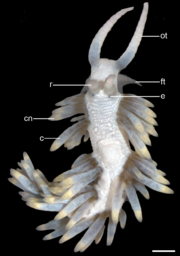
ot = oral tentacles,
ft = foot tentacles,
e = eye,
r = rhinophores,
c = cerata. This species has cnidosacs at the cerata tips.
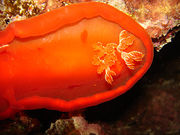
Description
The body forms of nudibranchs vary enormously, but because they are opisthobranchs, unlike most other gastropods they are bilaterally symmetrical because they have undergone secondary detorsion. Some species have venomous appendages on their sides. These are used to deter predators. Many also have a simple gut and a mouth with a radula.
They lack a mantle cavity.
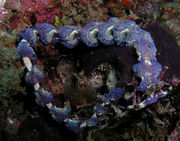
Their eyes are simple and able to discern little more than light and dark.[3] The eyes are set into the body, are about a quarter of a millimeter in diameter, and consist of a lens and five photoreceptors.[4]
They vary in adult size from 20 to 600 millimetres (0.79 to 24 in).
The adult form is without a shell or operculum (a bony or horny plate covering the opening of the shell, when the body is withdrawn).
The name nudibranch is appropriate, since the dorids (infraclass Anthobranchia) breathe through a "naked gill shaped" like branchial plumes of bushy extremities on their back, near their tail rather than using gills.[5] By contrast, on the back of the aeolids in the clade Cladobranchia there are brightly colored sets of protruding organs called cerata.
Nudibranchs have cephalic (head) tentacles, which are sensitive to touch, taste, and smell. Club-shaped rhinophores detect odors.
Life habits
Reproduction

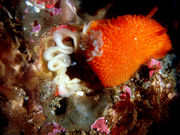
Nudibranchs are hermaphroditic, and thus have a set of reproductive organs for both sexes, but they can rarely fertilize themselves.
Nudibranchs typically deposit their eggs within a gelatinous spiral.[6]
Feeding
Most nudibranchs are carnivorous. Some feed on sponges, others on hydroids, others on bryozoans, and some eat other sea slugs, or, on some occasions, are cannibals and prey on members of their own species. Other groups feed on tunicates, barnacles, or anemones.

The surface dwelling nudibranch, Glaucus atlanticus is a specialist predator of siphonophores, such as the Portuguese Man O' War. This predatory mollusk sucks air into its stomach to keep it afloat and using its muscular foot it clings to the surface film. If it finds a small victim Glaucus simply envelopes it with its capacious mouth, but if the prey is a larger siphonophore the mollusk nibbles off its fishing tentacles, the ones carrying the most potent nematocysts. Like some others of its kind Glaucus does not digest the nematocysts; instead, it uses them to defend itself by passing them from its gut to the surface of its skin.[7]
Colors and camouflage
Among this group can be found the most colorful creatures on earth. In the course of evolution, sea slugs have lost their shell because they have developed other defense mechanisms. Their anatomy may resemble the texture and color of the surrounding plants, allowing them to camouflage (cryptic behavior). Others, as seen especially well on chromodorids, have an intense and bright coloring, which warns that they are distasteful or poisonous (aposematic coloration).
Nudibranchs that feed on hydroids can store the hydroids' nematocysts (stinging cells) in the dorsal body wall, the cerata.[8] The nematocysts wander through the alimentary tract without harming the nudibranch. Once further into the organ, the cells are brought to specific placements on the creature's hind body via intestinal protuberances. Nudibranches can protect themselves from the hydroids and their nematocysts. It is not yet clear how, but special cells with large vacuoles probably play an important role. They can also take in plants' chloroplasts (plant cell organelles used for photosynthesis) and use them to make food for themselves.
Some sponge-eating nudibranch concentrate the toxins from their prey sponge in their bodies, rendering themselves toxic to predators[9].
Another method of protection is the release of an acid from the skin. Once the specimen is physically irritated or touched by another creature, it will release the slime automatically.
Taxonomy
The taxonomy of the Nudibranchia is still under investigation. Many taxonomists in the past treated the Nudibranchia as an order, based on the authoritative work of Johannes Thiele (1931), who built on the concepts of Henri Milne-Edwards (1848).
- Infraorder Anthobranchia Férussac, 1819 (dorids)
- Superfamily Doridoidea Rafinesque, 1815
- Superfamily Doridoxoidea Bergh, 1900
- Superfamily Onchidoridoidea Alder & Hancock, 1845
- Superfamily Polyceroidea Alder & Hancock, 1845
- Infraorder Cladobranchia Willan & Morton, 1984 (aeolids)
- Superfamily Aeolidioidea J. E. Gray, 1827
- Superfamily Arminoidea Rafinesque, 1814
- Superfamily Dendronotoidea Allman, 1845
- Superfamily Metarminoidea Odhner in Franc, 1968
Newer insights derived from morphological data and gene-sequence research, have confirmed these ideas. On the basis of investigation of 18S rDNA sequence data, there is strong evidence for support of the monophyly of the Nudibranchia and its two major groups, the Anthobranchia/Doridoidea and Cladobranchia.[10] A study published in May 2001, has again revised the taxonomy of the Nudibranchia.[11] They are thus divided into two major clades:
- Anthobranchia (= Bathydoridoidea + Doridoidea)
- Dexiarchia nom. nov. (= Doridoxoidea + Dendronotoidea + Aeolidoidea + “Arminoidea”).
The dorids (infraorder Anthobranchia) have the following characteristics: the branchial plume forms a cluster on the posterior part of the neck, around the eyes. Fringes on the mantle do not contain any intestines.
The aeolids (infraorder Cladobranchia) have the following characteristics: Instead of the branchial plume, they have cerata. They lack a mantle. Only species of the Cladobranchia are reported to house zooxanthellae.
According to the taxonomy by Bouchet & Rocroi (2005), currently the most up-to-date system of classifying the gastropods , the Nudibranchia are a subclade within the clade of the Nudipleura. The Nudibranchia are then divided into two clades :
- Clade Euctenidiacea (= Holohepatica)
- Clade Nudibranchia Dexiarchia (= Actenidiacea)

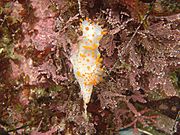
References
- ↑ Longman Pronunciation Dictionary (2nd edition), ISBN 0582364671
- ↑ doi:10.1017/S0025315400006044
This citation will be automatically completed in the next few minutes. You can jump the queue or expand by hand - ↑ http://ngm.nationalgeographic.com/2008/06/nudibranchs/holland-text/2
- ↑ CHASE, RONALD (June 1, 1974). "The Electrophysiology of Photoreceptors in the Nudibranch Mollusc, Tritonia Diomedia". Journal of experimental biology 60 (3): 707. PMID 4847278. http://jeb.biologists.org/cgi/content/abstract/60/3/707.
- ↑ Dayrat, B. (2005). "Advantages of naming species under the PhyloCode: An example of how a new species of Discodorididae (Mollusca, Gastropoda, Euthyneura, Nudibranchia, Doridina) may be named" (PDF). Marine Biology Research 1: 216–232. doi:10.1080/17451000510019141. https://campillos.ucmerced.edu/~bdayrat/PDF%20of%20Papers/Dayrat-MBR-2005.pdf. Retrieved 2009-06-14.
- ↑ Klussmann-Kolb A (2001). "The Reproductive Systems of the Nudibranchia (Gastropoda, Opisthobranchia): Comparative Histology and Ultrastructure of the Nidamental Glands with Aspects of Functional Morphology". Zoologischer Anzeiger 240 (2): 119–136. doi:10.1078/0044-5231-00011. http://www.ingentaconnect.com/content/urban/351/2001/00000240/00000002/art00011.
- ↑ Piper, Ross (2007), Extraordinary Animals: An Encyclopedia of Curious and Unusual Animals, Greenwood Press.
- ↑ Frick, K (2003). "Predator Suites and Flabellinid Nudibranch Nematocyst Complements in the Gulf of Maine.". In: SF Norton (ed). Diving for Science...2003. Proceedings of the American Academy of Underwater Sciences (22nd Annual Scientific Diving Symposium). http://archive.rubicon-foundation.org/4744. Retrieved 2008-07-03.
- ↑ Gosliner, T.M. 1987. Nudibranchs of Southern Africa ISBN 0-930118-13-8
- ↑ Wägele H. & Willan R. C. (September 2000). "Phylogeny of the Nudibranchia". Zoological Journal of the Linnean Society 1 (1): 83–181. doi:10.1111/j.1096-3642.2000.tb02196.x.
- ↑ Schrödl M., Wägele H. & Willan R. C. (2001). "Taxonomic Redescription of the Doridoxidae(Gastropoda: Opisthobranchia), an Enigmatic Family of Deep Water Nudibranchs, with Discussion of Basal Nudibranch Phylogeny". Zoologischer Anzeiger, 240 (1): 83. doi:10.1078/0044-5231-00008. http://www.ingentaconnect.com/content/urban/351/2001/00000240/00000001/art00008.
Further reading
- Gary R. McDonald. July 29, 2006. Nudibranch Systematic Index. Institute of Marine Sciences. Paper Nudibranch_Systematic_Index. - Note: This is a good resource for getting a species list in certain genera, but it is not good for ascertaining the taxonomy of a genera, because it does not use the taxonomy of the Gastropoda (Bouchet & Rocroi, 2005).
- Neville Coleman (2008). Nudibranchs Encyclopedia: Catalogue of Asia/Indo-Pacific Sea Slugs. Neville Coleman's Underwater Geographic. ISBN 0947325417
External links
- Sea Slug Forum by William B. Rudman
- World of Water by Neville Coleman (Encyclopedia and photos)
- Images and information on Australian nudibranchs
- Nudibranchs in their natural environment, Scuba Diving - Narooma NSW
- Nudi Pixel: Online resource for nudibranchs and sea slugs identification using photographs
- Various nudibranch species from Indonesia, Philippines and Thailand
- Nudibranch gallery
- Bibliography and portal to opisthobranch, nudibranch & seaslug information
- Nudibranch photo gallery from Bali
- Scottish Nudibranchs: Online resource for identification of species found in Scottish waters
- Born to be Wild: Sea Slugs, 04/30/2008
- http://ngm.nationalgeographic.com/2008/06/nudibranchs/doubilet-photography?email=focus_20080523
- Sea slugs of Hawaii
- Marine Conservation Cambodia: A Photographic Database of Cambodian Nudibranch
Video
- The Lynx Nudibranch HD clip of Phidiana lynceus carefully consuming a hydroid, Myrionema amboinense.